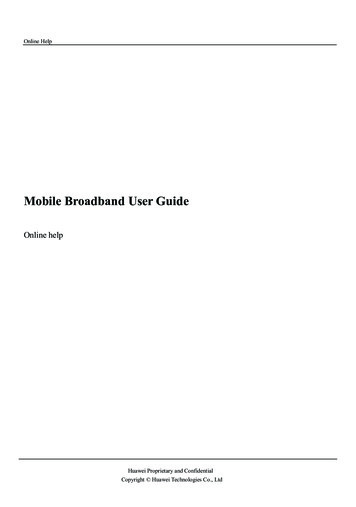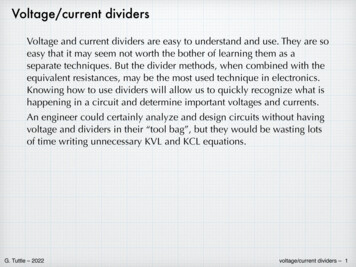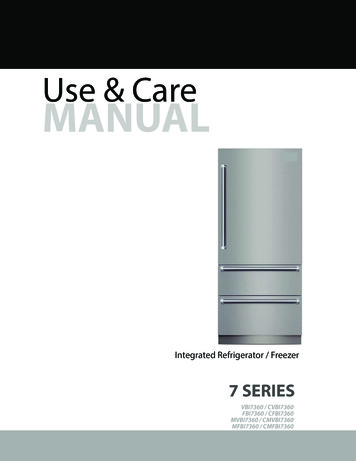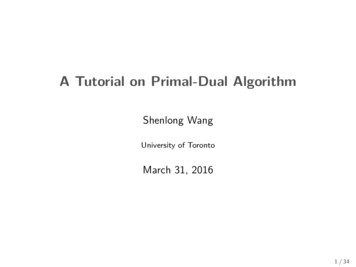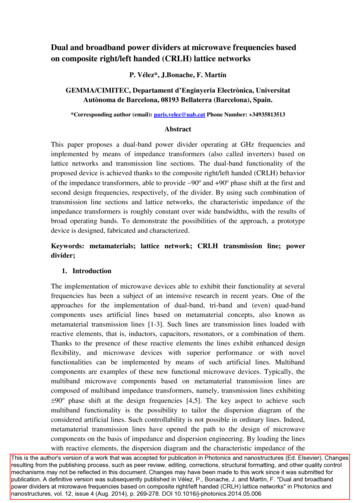
Transcription
Dual and broadband power dividers at microwave frequencies basedon composite right/left handed (CRLH) lattice networksP. Vélez*, J.Bonache, F. MartínGEMMA/CIMITEC, Departament d’Enginyeria Electrònica, UniversitatAutònoma de Barcelona, 08193 Bellaterra (Barcelona), Spain.*Corresponding author (email): paris.velez@uab.cat Phone Number: 34935813513AbstractThis paper proposes a dual-band power divider operating at GHz frequencies andimplemented by means of impedance transformers (also called inverters) based onlattice networks and transmission line sections. The dual-band functionality of theproposed device is achieved thanks to the composite right/left handed (CRLH) behaviorof the impedance transformers, able to provide 90o and 90o phase shift at the first andsecond design frequencies, respectively, of the divider. By using such combination oftransmission line sections and lattice networks, the characteristic impedance of theimpedance transformers is roughly constant over wide bandwidths, with the results ofbroad operating bands. To demonstrate the possibilities of the approach, a prototypedevice is designed, fabricated and characterized.Keywords: metamaterials; lattice network; CRLH transmission line; powerdivider;1. IntroductionThe implementation of microwave devices able to exhibit their functionality at severalfrequencies has been a subject of an intensive research in recent years. One of theapproaches for the implementation of dual-band, tri-band and (even) quad-bandcomponents uses artificial lines based on metamaterial concepts, also known asmetamaterial transmission lines [1-3]. Such lines are transmission lines loaded withreactive elements, that is, inductors, capacitors, resonators, or a combination of them.Thanks to the presence of these reactive elements the lines exhibit enhanced designflexibility, and microwave devices with superior performance or with novelfunctionalities can be implemented by means of such artificial lines. Multibandcomponents are examples of these new functional microwave devices. Typically, themultiband microwave components based on metamaterial transmission lines arecomposed of multiband impedance transformers, namely, transmission lines exhibiting 90o phase shift at the design frequencies [4,5]. The key aspect to achieve suchmultiband functionality is the possibility to tailor the dispersion diagram of theconsidered artificial lines. Such controllability is not possible in ordinary lines. Indeed,metamaterial transmission lines have opened the path to the design of microwavecomponents on the basis of impedance and dispersion engineering. By loading the lineswith reactive elements, the dispersion diagram and the characteristic impedance of theThis is the author's version of a work that was accepted for publication in Photonics and nanostructures (Ed. Elsevier). Changesresulting from the publishing process, such as peer review, editing, corrections, structural formatting, and other quality controlmechanisms may not be reflected in this document. Changes may have been made to this work since it was submitted forpublication. A definitive version was subsequently published in Vélez, P., Bonache, J. and Martín, F. "Dual and broadbandpower dividers at microwave frequencies based on composite right/left handed (CRLH) lattice networks" in Photonics andnanostructures, vol. 12, issue 4 (Aug. 2014), p. 269-278. DOI 10.1016/j-photonics.2014.05.006
lines can be adjusted, so that certain specifications not easily achievable withconventional lines can be satisfied with metamaterial transmission lines. The simplestrealistic artificial lines based on metamaterial concepts are the so-called compositeright/left handed (CRLH) lines [6]. These lines can be implemented by loading a hostline with series capacitors and shunt inductors (CL-loaded approach) [7-9], or byloading a host line with resonant elements, such as split ring resonators (SRRs) [10] orcomplementary split ring resonators (CSRRs) [11], and other reactive elements (shuntinductors or series capacitors). The latter approach has been designated as the resonanttype approach [12-14].Let us now focus the attention on the CL-loaded approach. The equivalent T-circuitmodel of the unit cell of these lines is depicted in Fig. 1. The dispersion diagram and theBloch impedance (or ratio between voltage and current for the Bloch waves consideringa periodic structure composed of such cells) of this structure can be inferred from thecircuit model according to [15]cos l 1 Z s ( )Z p ( )(1)Z B Z s ( )[Z s ( ) 2Z p ( )](2)where Zs and Zp are the impedances of the series and shunt branch, respectively, of theT-circuit, is the phase constant and l the unit cell length. If only one cell or few cellsare considered, then expression (2) is identified with the image impedance, but both theBloch and the image impedance are the equivalent of the characteristic impedance inordinary lines. The resulting dispersion diagram exhibits a region (at low frequencies)where the phase and group velocities are antiparallel (left handed band), and a region (athigher frequencies) where both velocities have the same sign (right handed band).Hence these lines exhibit a CRLH behavior. In the left handed band, wave propagationis backward, whereas in the right handed band wave propagation is forward (i.e., as inordinary lines). Typically, a band gap appears between the backward and forwardtransmission bands, unless the line is balanced. The balanced condition is achievedwhen the series and shunt resonance frequencies are identical [2], namely s 1LR C L 1LL C R p(3)In this case, the transition between the left handed and the right handed band iscontinuous, the phase velocity is infinite at the transition frequency, and the groupvelocity exhibits a finite value at that frequency. CRLH transmission lines described bythe model of Fig. 1 exhibit a bandpass behavior. Interestingly, it is possible to designthe line in order to exhibit the same absolute value of phase shift at two differentfrequencies (f1 and f2), with the same values of the characteristic impedance.Considering that a single unit cell is used (in order to reduce dimensions), the conditionsto univocally determine the four reactive elements of the circuit of Fig. 1, for animpedance transformer, are:
s ( 1 ) Z A(4.a) p ( 1 ) Z A(4.b) s ( 2 ) Z A(4.c) p ( 2 ) Z A(4.d)where Zs j s, Zp j p, 1 2 f1, 2 2 f2, ZA is the required characteristic impedanceof the transformer (a real quantity) at the design frequencies, and the phase of thetransformer is 90o at f1 and 90o at f2. Fig. 2 depicts the dispersion and characteristicimpedance of the transformer with ZA 70.71 at f1 1GHz and f2 2GHz.Fig. 1.Equivalent T-circuit model of the unit cell of a canonical CRLH transmission line.a) b) 150 lZB( )100 0,51,01,52,02,53,05000,51,01,52,02,53,0Frequency (GHz)Frequency (GHz)Fig. 2.Dispersion diagram (a) and characteristic impedance (b) of a dual-band impedance transformerwith ZA 70.71 , implemented by means of the circuit of Fig. 1. The operating frequencies are f1 1GHzand f2 2GHz. The element values that result by solving (4) are: LL 5.62nH, LR 22.5 nH, CL 0.56pF,CR 2.25pF.Many dual-band components have been implemented following this strategy [5,16], andby increasing the number of reactive elements, quad-band components have also beenreported (such components are based on the so-called extended, or generalized, CRLHtransmission line concept [17-19], and several prototypes are reported in [20-22]). Animportant difference between CRLH lines and ordinary lines is the frequencydependence of the characteristic impedance. Whereas it is constant in conventionallines, it strongly depends on frequency in CRLH transmission lines. Note however thatit is scarcely dependent on frequency in the vicinity of the transition frequency inbalanced lines [2]. For this reason, many devices have been designed with multi-cellbalanced structures, each one exhibiting a small phase shift at the required frequencies.Typically, the first (left handed) band in CRLH lines is narrow and the characteristicimpedance in the vicinity of the frequency where the phase shift is 90o variessubstantially with frequency. The result, when these lines are used for the
implementation of dual-band devices based on impedance transformers, is a narrowband at the first operating frequency [5,16].In this paper, dual-band impedance transformers are implemented following a differentapproach: the use of lattice networks combined with transmission line sections. Througha proper design, these artificial lines can be designed to exhibit a CRLH behavior with anearly frequency independent characteristic impedance. As will be shown, the designeddual-band device (a power divider) exhibits two operating bands with impedancematching over broad bandwidths, as compared to other reported dual-band components.2. Lattice networks exhibiting CRLH behavior: theory and state of the artThe CRLH and the generalized CRLH transmission lines mentioned in the previoussection support wave propagation in a limited frequency band. All-pass structuresexhibiting left handed, right handed or CRLH wave transmission can be implementedby using the so-called lattice networks [23]. Indeed, all-pass CRLH transmission lineswith arbitrary order can potentially be synthesized with these lattice network structures[24]. However, the practical implementation of these lattice (or X-type) networks is notstraightforward, as will be later discussed.Let us now consider an X-type unit cell like the one shown in Fig. 3(a), i.e., a latticenetwork, with impedance Zs in the series branches and Zp in the cross diagonal arms. Bycalculating the elements of the impedance matrix, this two-port network can betransformed to its equivalent T-circuit model, depicted in Fig. 3(b). Using (1) and (2),the phase constant and characteristic impedance of the generalized lattice network ofFig. 3(a) are given by:Z Zs(5)cos( l ) pZ p ZsZB Zs Z p(a)Zsa)Zp(6)(b)b)ZpZsZs(Zs- Zp)/2ZsFig. 3.Lattice-network unit cell (a) and its equivalent T-circuit model (b).Let us now consider that the element of the series and cross branches is an inductor (Zs j LR) and a capacitor (Zp j/ CR), respectively (Fig. 4a). Evaluation of (5) and (6)gives:1 LR C R 2(7)cos( l ) 1 LR C R 2
ZB LC(8)Inspection of (7) and (8) reveals that the network of Fig. 4(a) is an all-pass structure (thecharacteristic impedance is real and frequency independent, like the one of an ordinarytransmission line), and that wave propagation is forward from DC up to (theoretically)unlimited frequencies (the dispersion diagram is also depicted in Fig. 4a). If the inductorand capacitor are interchanged (Fig. 4b), the characteristic impedance is also constantand given by (8), whereas the phase constant is found to be:cos( l ) 1 LL C L 21 LL C L 2(9)and wave propagation is backward in the whole electromagnetic spectrum (see thedispersion diagram depicted in Fig. 4b). If the phase shift is small enough, the networksof Fig. 4(a) and (b) mimic a conventional line and a purely left-handed line,respectively.By adequately choosing the reactive elements of the series and cross arms of the Xnetwork, all-pass CRLH structures of arbitrary order can be obtained [24]. For instance,Figs. 4 (c) and (d) show the lattice networks corresponding to order-2 all-pass CRLHand dual-CRLH lines, respectively. To obtain all-pass structures, it is necessary that thezeros and poles of the reactance of the series branch coincide with the zeros and poles ofthe susceptance of the cross branch. For the specific case of order-2 lattice networks, thecondition is similar to the balance condition for T- or -type CRLH transmission lines: s 1 Ls C s1 p oLpC p(10)where Ls, Cs and Lp, Cp are the reactive elements of the series branch and cross branch,respectively, and o is the transition frequency. For the network of Fig. 4(c), expression(5), subjected to (10), rewrites as:2 o2 1 Ls C p 1 2 cos( l ) 2 o2 2 1 Ls C p 1 2 2(11)whereas the dispersion relation for the network of Fig. 4(d) is:2 o2 1 L p C s 1 2 cos( l ) 2 o2 2 1 L p C s 1 2 2(12)
The dispersion curves are also depicted in Figs. 4(c) and (d). In both cases, thecharacteristic impedance is given by (8), with L Ls and C Cp. LR(a) CR lCR LR CL LL l(b)LL CL Cs(c) LpLpCpCp lLs LsCs Ls CsLpLpCpCpLsCs l(d) Fig. 4.Examples of lattice networks and their corresponding dispersion curves. (a) order-1 right handed;(b) order-1 left handed; (c) order-2 CRLH; (d) order-2 dual CRLH.
From a practical viewpoint, the physical implementation of the order-2 lattice networksof Figs. 4(c) and (d) is not straightforward. An alternative to implement all pass order-2CRLH lines is to combine purely left handed and purely right handed X-type cells, asdepicted in Fig. 5(a). In this case, the following condition must be satisfied:LRLL ZBCRCL(13)which gives the characteristic impedance of the whole all-pass network. The transitionfrequency is given by that frequency satisfying: 1 LR C R o2 1 LL C L o2 0arccos arccos2 2 1 LR C R o 1 LL C L o (14)namely: o 1 LR C L1LL C R(15)In particular, if LRCR LLCL (which, according to 13, means that LR LL and CR CL),the transition frequency can also be expressed as: o 1 LR C R1LL C L(16)corresponding to the frequency where the purely left handed cell and the right handedcell experience a phase shift of l 90o and l 90o, respectively (thus providing anoverall phase shift of l 0o). Fig. 5(b) shows the dispersion diagram corresponding tothe structure of Fig. 5(a) for the indicated element values.(b) (a)LLLRLLCL CRCRLR lCL Fig. 5. CRLH artificial transmission line unit cell consisting of two cascaded order-1 X-type right handedand left handed cells (a), and dispersion diagram (b). Elements are: CL CR 1.061 pF and LL LR 2.652 nH (fo 3GHz, and it is indicated by a bold circle in b).It is worth mentioning that, in spite that the networks of Figs. 4(c) and 5(a) exhibitsimilar dispersion curves; there is not an element transformation that makes themequivalent. Notice that the dispersion relation (with the frequency variable in the x-axis)for the structure of Fig. 5(a) is a concave function at all frequencies. However, for the
order-2 CRLH X-type cell of Fig. 4(c), the dispersion relation is convex for frequenciesbelow o, and concave above that frequency (i.e., there is an inflexion point at o).Although the synthesis of a cascaded order-1 left handed and right handed X-type cellsis simpler than an order-2 CRLH lattice network, the former structure may presentcertain limitations due to the curvature of its dispersion relation. For instance, it is notpossible to implement dual-band components based on dual-band ( 90o) impedanceinverters implemented with single unit cells (like the one depicted in Fig. 5a) with aratio of operating frequencies smaller than 3. The reason is that, due to the curvature ofthe dispersion diagram (see Fig. 5b), the second operation frequency (indicated by atriangle in Fig. 5b) is always above the one indicated by a square, this one being thesecond operating frequency if the dispersion curve was a straight line (dashed line inFig. 5b). Notice that this frequency is exactly three times the one indicated by a star (thefirst operating frequency). Hence the above statement is graphically demonstrated.The synthesis of CRLH all-pass artificial lines can be further simplified by cascading anX-type left handed unit cell with a transmission line section with identical characteristicimpedance, as depicted in Fig. 6(a), or with a pair of transmission lines sections (at theinput and output ports of the left handed X-type cell). A typical dispersion curve for thestructure of Fig 6(a) is depicted in Fig. 6(b). In this case, due to the presence of adistributed element, the phase of the structure grows indefinitely.(a) (b) LLLL lCL CL Fig. 6. CRLH artificial transmission line unit cell consisting of an order-1 X-type left handed cellcascaded to an ordinary transmission line section with phase constant k and characteristic impedance Zo.Concerning the implementation, X-type networks are differential structures with crossbranches. Therefore, as mentioned above, their synthesis is not simple. CRLH artificiallines were implemented by Bongard et al. [25-27] by combining X-type left handedcells and transmission line sections. The structure reported in [27] utilizes paired stripstechnology with two additional metal levels to implement the series capacitances of theleft handed X-type cells, and via holes to implement the cross inductances. Thestructure, designed to exhibit a transition frequency at fo 6GHz, exhibits very broadbands at both sides of fo.Using the unit cell structure of Fig. 6(a), a broad-band (matched from DC to millimeterwaves) silicon-integrated CRLH transmission line using a monolayer CPW host linewas proposed in [28]. The measurements carried out in [28] demonstrate a balancedCRLH behavior from 5GHz up to 35 GHz, with a transition frequency at fo 20 GHz.
The interesting aspect of the structure of [28] is that it is implemented using a singlemetal layer. Since the series capacitances must be implemented in both conductors ofthe transmission line, the ground conductors of the host CPW must be of finite width.The required capacitances were realized by interdigital capacitors, whereas for theimplementation of the crossed inductors, the solution proposed in [28] was toimplement each of the inductances in a different slot of the CPW. Since the resultingstructure is strongly asymmetrical, the excitation of the odd parasitic mode wasprevented by the use of the bridges. Thus, the structure indeed uses two metal levels.Other X-type left handed, right handed and CRLH planar structures implemented byusing two metal levels are reported in [29].It is worth mentioning that from the equivalence between terminated coupled linesections and lattice networks [30], another approach for the physical implementation oflattice network based artificial CRLH lines was presented in [24]. The unit cell is basedon the coupled-microstrip Schiffman section [31], which is an easily implementablestructure that does not require the use of via-holes or air bridges, as opposed to the cellspresented in [25-29]. Indeed, coupled-line sections were earlier used in [32,33] to obtainCLRH transmission lines, but with limited performance due to the different even- andodd-mode phase velocities of the coupled lines. This issue was satisfactorily solved in[24]. Thus, terminated coupled line sections offer a simple approach for theimplementation of lattice network CRLH transmission lines. Obviously, this is a fullydistributed approach that inherently increases line size as compared to lattice networkCRLH lines based on lumped or semilumped (planar) elements.3. Dual-band power dividers based on left handed lattice networks andtransmission line sectionsThe dual-band power divider presented in this paper is implemented with a pair of dualband 70.71 impedance transformers based on the CRLH structure of Fig. 6, i.e., acombination of a purely left handed lattice network and a transmission line section. Theschematic of this divider is depicted in Fig. 7. The impedance of the impedancetransformers (ZA 70.71 ) has been set to this value in order to achieve good inputmatching, considering reference impedances of Zo 50 at the ports. At the designfrequencies the phase shift of the impedance transformers is 90o, and hence theimpedance seen at the input port of each transformers, given by [15]Z2Z in,T A(17)Zois 100 , and the impedance seen from port 1 is Zin 50 at the design frequencies.
Fig. 7.Schematic of the dual-band power divider.By choosing the operating frequencies as f1 1.7GHz and f2 5.4GHz, the conditionsto implement the impedance transformers are:LL(18)ZA 70.71 CL 1 LL C L 12arccos 2 1 LL C L 1 TL ( 1 ) 90 o (19) 1 LL C L 22arccos 2 1 LL C L 2 TL ( 2 ) 90 o (20)where TL( ) is the phase of the transmission line section, given by TL ( ) klTL vplTL(21)vp and lTL being the phase velocity and length of the transmission line section,respectively.Notice that equations (18)-(20) have three unknowns (LL, CL and lTL) that can beunivocally determined. Solving (18)-(20) with the design frequencies given above, theunknowns are found to be: LL 2.09nH, CL 0.419pF, and lTL/vp 19.18ps (obviously,the phase velocity depends on the effective dielectric constant of the considered line).For the implementation of the divider using the inferred CRLH impedance transformers,we have considered the topology depicted in Fig. 8. Basically, the series capacitances ofthe left-handed lattice network are implemented by means of metallic gaps, whereas thecrossed inductances are implemented by means of narrows strips with vias (with0.15mm radius) in order to connect the upper metal with the lower metal. Transmissionline sections with the required values (ZB 70.71 and lTL/2vp 9.59 ps) are added at bothsides of the X-type left handed unit cell to provide the needed phase shift. Thistransmission line sections are implemented by means of double sided parallel strip line(DSPSL) [34] with an offset equal to 0.66 mm (this gives the required impedance) andconnected to the X-type left handed lattice network with tapered line sections, that havebeen optimized to achieve the required phase response (the tapper lines are necessary to
connect the lines to the X-type network, which has the indicated shape in order toaccommodate the inductive vias, and to provide the required capacitive values).(a)L(b)ViaslTLP1W P1P1'Ll Ll2WTLScP2LTP2P2'WcLcFig.8. 3D view of the dual-band impedance inverter based on an X-type left handed lattice sandwichedbetween two transmission line sections (a), and top view with ports and relevant dimensions indicated(b). The lower metal is depicted in grey. Dimensions are: W 6.6 mm, L 8.4 mm, Wc 2.6 mm, Lc 0.75 mm, Sc 0.16 mm, lLT 2.22 mm, LT 1.13 mm, WTL 1.43 mm, Ll 1.2 mm and Ll2 0.95 mm.The width of the narrow strips is 0.16 mm.Fig. 9 depicts the dispersion diagram and Bloch impedance of the dual-band inverter ofFig. 8 inferred from the schematic of Fig. 6 (by considering the element values andtransmission line parameters of the structure) and also from the electromagneticresponse (obtained by means of the Agilent Momentum commercial software). Theconsidered substrate is the Rogers RO3010 with dielectric constant r 10.2 andthickness h 1.27mm. As expected, the required phase shift at the operating frequenciesis achieved. Since the structure in not perfectly balanced, a singularity is observedaround the transition frequency (3.4GHz). This singularity appears also in thecharacteristic impedance, but it is nearly frequency independent in the vicinity of theoperating frequencies. 250(a)(b) lf f Circuit Sim.EM Sim.0,5 1,0 1,5 2,0 2,5 3,0 3,5 4,0 4,5 5,0 5,5 6,0ZB( )200 Circuit Sim.EM Sim.1501005000,5 1,0 1,5 2,0 2,5 3,0 3,5 4,0 4,5 5,0 5,5 6,0Frequency (GHz)Frequency (GHz)Fig. 9. Dispersion diagram (a) and characteristic impedance (b) of the dual-band impedance transformer,with ZA 70.71 , implemented by means of the topology of Fig. 8.The designed and fabricated dual-band power divider with final dimensions is depictedin Fig. 10. Notice that the 50 access line in port 1 is implemented by means of adouble sided parallel strip line.
L(a)P1P1’WP2P2’P3P3’(c)(b)Fig. 10. Topology (a) and photograph, top (b) and bottom (c), of the fabricated dual band power divider.Dimensions are: W 9.9 mm, L 19.2 mm.The circuit simulation, electromagnetic simulation and measured insertion loss (S31 isvery similar to S21 and is not depicted) and return loss (S11) are depicted in Fig.11. Theagreement between circuit, electromagnetic simulation and measurement is reasonable.The measured insertion loss (notice that the ideal value is 3 dB) and return loss at thedesign frequencies are IL(f1) 3.6 dB, RL(f1) 21.3 dB, IL(f2) 3.7 dB, and RL(f2) 20.7 dB. Device dimensions are 0.14 g 0.28 g, where g is the guided wavelength atf1. As it was mentioned before, this type of structures exhibits (ideally) frequencyindependent characteristic impedance, resulting in broader bandwidths, as compared toother CRLH based circuits. Indeed, the designed device exhibits a roughly constantsimulated insertion loss and the matching level is better than 10dB in very broadfrequency bands in the vicinity of the design frequencies.0S21(dB), S11(dB)-10-20S21S11-30-40Circuit Sim.EM Sim.Measure-500,5 1,0 1,5 2,0 2,5 3,0 3,5 4,0 4,5 5,0 5,5 6,0Frecuency (GHz)Fig. 11. Frequency response of the fabricated dual-band power divider designed to operate at f1 1.7GHzand f2 5.4GHz (b). S31 has not been included since this is similar to S21.
4. ConclusionIn this paper, the potentiality of lattice network unit cells for the implementation ofenhanced bandwidth microwave components has been demonstrated. These all-passnetworks can be designed to exhibit left handed, right handed or composite right/lefthanded (CRLH) behaviour. Specifically in this work, to ease design and synthesis, theauthors have combined a left handed lattice unit cell with a pair of ordinarytransmissions line sections in order to implement a dual-band impedance inverter withbroad operating bandwidths. This inverter has been then used for the implementation ofa dual-band T-junction power divider. Thanks to the nearly constant characteristicimpedance of the inverters in the vicinity of the design frequencies, the divider has beenfound to exhibit good matching level and power splitting over wide bands. To theauthors knowledge, this is the first dual-band power divider implemented by means ofCRLH structures (impedance inverters) that combine X-type networks and transmissionline sections.5. AcknowledgementsThis work has been supported by MINECO-Spain (projects TEC2010-17512 andCSD2008-00066), and by AGAUR-Generalitat de Catalunya, through project2014SGR-157. Paris Vélez is in debt to MINECO (Spain) for supporting his workthrough the FPU grant AP2010-0467.References1. G.V. Eleftheriades and K.G. Balmain, Negative refraction metamaterials: fundamental principles andapplications, John Wiley & Sons, Inc, New Jersey 2005.2. C. Caloz and T. Itoh, Electromagnetic Metamaterials: Transmission Line Theory and MicrowaveApplications, John Wiley & Sons, 2006.3. R. Marqués, F. Martín and M. Sorolla, Metamaterials with negative parameters: theory, design andmicrowave applications, John Wiley & Sons, Inc, New Jersey 2008.4. I.H. Lin, M. De Vincentis, C. Caloz and T. Itoh, “Arbitrary dual-band components using compositerigth/left handed transmisión lines”, IEEE Trans. Microwave Theory and Techniques, vol. 52, pp.1142-1149, April 2004.5. J. Bonache, G. Sisó, M. Gil, A. Iniesta, J. García-Rincón and F. Martín, “Application of compositeright/left handed (CRLH) transmission lines based on complementary split ring resonators (CSRRs) tothe design of dual band microwave components”, IEEE Microwave and Wireless Components Letters,vol. 18, pp. 524-526, August 2008.6. C. Caloz and T. Itoh, “Novel microwave devices and structures based on the transmission lineapproach of metamaterials”, IEEE-MTT Int’l Microwave Symp, vol. 1 Philadelphia, PA, pp. 195-198,June 2003.7. A. K. Iyer and G. V. Eleftheriades. “Negative refractive index metamaterials supporting 2-D waves,”in IEEE-MTT Int’l Microwave Symp., vol. 2, Seattle, WA, pp. 412– 415, June 2002.8. A. A. Oliner. “A periodic-structure negative-refractive-index medium without resonant elements,” inURSI Digest, IEEE-AP-S USNC/URSI National Radio Science Meeting, San Antonio, TX, pp. 41,June 2002.9. C. Caloz and T. Itoh. “Application of the transmission line theory of left-handed (LH) materials to therealization of a microstrip LH transmission line,” in Proc.IEEE-AP-S USNC/URSI National RadioScience Meeting, vol. 2, San Antonio, TX, pp. 412–415, June 2002.10. J.B. Pendry, A.J. Holden, D.J. Robbins and W.J. Stewart, “Magnetism from conductors and enhancednonlinear phenomena”, IEEE Transactions Microwave Theory Tech., vol. 47, pp. 2075-2084, Nov.1999.
11. F. Falcone, T. Lopetegi, J.D. Baena, R. Marqués, F. Martín and M. Sorolla, “Effective negative- stop-band microstrip lines based on complementary split ring resonators”, IEEE Microwave andWireless Components Letters, vol. 14, pp. 280-282, June 2004.12. F. Martín, F. Falcone, J. Bonache, R. Marqués and M. Sorolla, “Split ring resonator based left handedcoplanar waveguide”, Appl. Phys. Lett., vol. 83, pp. 4652-4654, December 2003.13. J.D. Baena, J. Bonache, F. Martín, R. Marqués, F. Falcone, T. Lopetegi, M.A.G. Laso, J. García, I Gil,M. Flores-Portillo and M. Sorolla, “Equivalent circuit models for split ring resonators andcomplementary split rings resonators coupled to planar transmission lines”, IEEE Transactions onMicrowave Theory and Techniques, vol. 53, pp. 1451-1461, April 2005.14. M. Durán-Sindreu, A. Vélez, G. Sisó, J. Selga, P. Vélez, J. Bonache, and F. Martín “Recent advancesin metamaterial transmission lines based on split rings”, Proceedings of the IEEE, vol. 99, pp. 17011710, October 2011.15. D.M. Pozar, Microwave Engineering, Addison Wesley: New York; 1993.16. M. Durán-Sindreu, A. Vélez, F. Aznar, G. Sisó, J. Bonache and F. Martín, “Application of Open SplitRing Resonators and Open Complementary Split Ring Resonators to the Synthesis of ArtificialTransmission Lines and Microwave Passive Components”, IEEE Trans. Microwave Theory andTechniques, vol. 57, pp. 3395-3403, Dec. 2009.17. A. Rennings, S. Otto, J. Mosig, C. Caloz, and I. Wolf
*Corresponding author (email): paris.velez@uab.cat Phone Number: 34935813513 Abstract . approaches for the implementation of dual-band, tri-band and (even) quad-band . model of the unit cell of these lines is depicted in Fig. 1. The dispersion diagram and the






